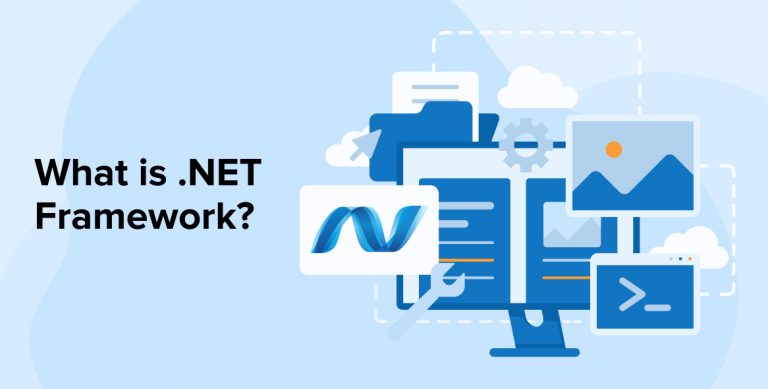
When the world is stepping into a newer way of doing business, technologies make a difference. You must choose one that makes your developed application a secure platform. What else can you think of other than the .NET framework for developing multi-functional, secure, and robust applications using the .NET development platform? It has definitely gained much acceptance from the world and there are multiple reasons for it with the upcoming .NET Core 7.0 framework and update too. So, now you have many reasons to choose a .NET development company. This blog post is aimed to showcase what are the important things about the ASP.NET framework, .NET programming language, essential components, Dot Net framework architecture, key features, and benefits. Let’s start!
1. What is .NET Framework?

Microsoft ASP.NET is an open-source web development programming language used to develop web-based applications and other web services. It is backed up by a .NET support library with a variety of options for building different web solutions. Before we dig deep into the .NET framework let’s find out how popular the .net framework is on Google Trends.
ASP.NET MVC has an alternative ASP.NET Web Forms that can help you build web-based applications, mobile apps, and desktop applications faster and more efficiently. It provides maximum customer satisfaction by striking the right balance between the cost and quality of the .NET project.
You can now easily build, deploy and maintain web applications within the .NET ecosystem using .NET features.
- There is a specific design pattern that ASP.NET MVC follows that can easily divide UI and complex codes. This will allow the Software Engineers to easily perform tests and conduct test-driven development. This enables easier and simpler ways to secure codes.
- ASP.NET is scalable, feature-rich, and powerful to develop all types of .NET applications with advanced key features and exceed expectations for business apps. When businesses use ASP.NET for their applications, the developers, designers, and coders can collect codes to build websites and other web applications with rapid business scaling options.
- Since the .NET platform is capable of serving so many features, it is still light weighted and can easily help create dynamic websites that work on C# and Visual Basic.
- The webHooks of ASP.NET can be connected using Web APIs and SaaS services.
- It does not have limited functions or tools, it has widespread advantages that help businesses to build outstanding web solutions.
2. Things to be Considered About .NET Framework
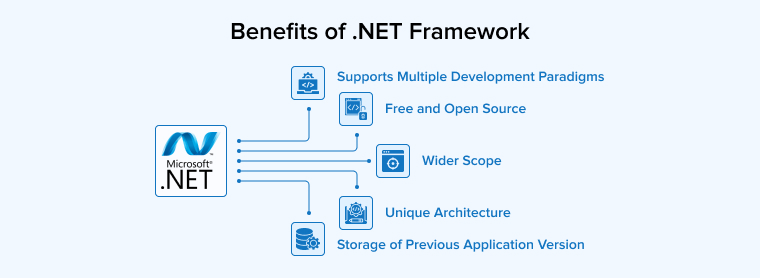
There are some features of ASP. NET makes it so popular among users. Most developers must be aware of the .NET framework and its features. So, here in this blog, you will see a quick run-through of how these features contribute to building a top-notch .NET developed application. Let’s get into the details of what these features of the .NET framework add to the .NET application you develop.
2.1 Free and Open Source
For businesses using .NET, the entire .NET Core framework is free and has no licensing costs, providing skilled developers with a large sandbox in which to create futuristic enterprise-grade apps. GitHub is a great place to find out more about the .NET Core source code. Many active developers contribute to .NET Core development with the goal of improving existing features, introducing new ones, and resolving problems and difficulties.
There are several advantages to .NET being an open-source developer platform. For one thing, you can learn more about the inner workings of .NET, allowing you to create apps for the .NET platform more effectively. You may also help its growth if you have specific suggestions!
2.2 Framework Architecture
First, let’s see how .NET framework Architecture looks,
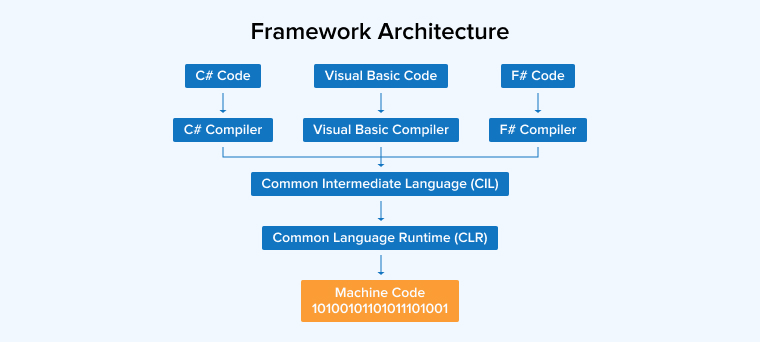
The .NET framework has a different architecture than other frameworks. CoreFX is the only framework for .NET 5. The first level of .NET framework architecture includes CTS and CLS. CTS is a common type system and CLS is a common language specification. It is a subset of CTS. All instruction is in CLS i.e. instruction of CTS is written in CLS.
The second level in this .net architecture includes MSIL- Microsoft Intermediate Languages. The framework, as indicated by Microsoft, would run on mono and CoreCLR. CoreCLR for most developers, would be the target, which replaces .NET, mono, and NET Core. Nonetheless, mono would still be the target runtime and will likely continue to be utilized in gaming, mobile, and other less common operating instances.
The .NET development supports two kinds of coding
1. Managed Code
Managed code is a resource within your application domain. The resources within the domain are quicker.
2. Unmanaged Code
Unmanaged code is code that is created outside of the .NET Framework. Unmanaged programs are those that do not operate under the supervision of the Common Language Runtime (CLR), and some .NET programming languages such as C++, may be used to build such .NET apps, which, for example, access low-level operating system functions. Unmanaged code includes background compatibility with VB, ASP, and COM code.
2.3 Supports Multiple Development Paradigms for Web Development
People may be unaware of how the .NET framework supports different programming languages. NET also offers the ability to use the code of one language within the code of another, which opens up a plethora of new possibilities. As .NET is a unified platform it can be easily organized with all the standard web development platforms.
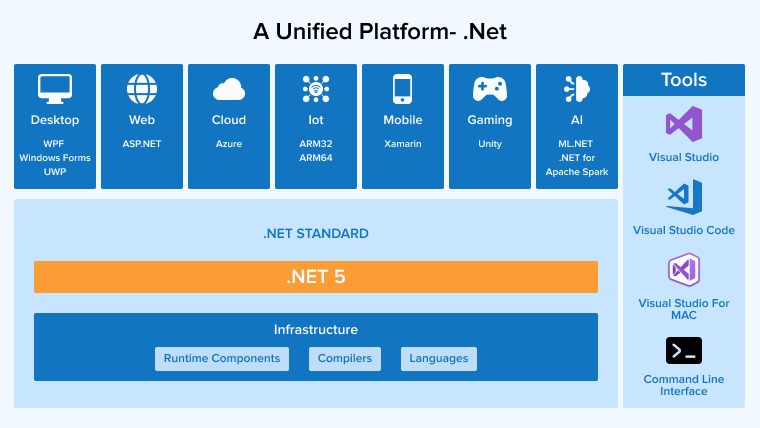
In general, there are several methods and developer tools for web development. ASP.NET offers three approaches to web development to accommodate users with varying goals and skill sets. WebForms caters to those who have a strong understanding of WinForms and have medium to advanced expertise in RAD, whereas MVC caters to people who want complete control over HTML and have knowledge of frameworks such as Ruby on Rails.
2.4 Dot Net Has a Wider Scope
Let’s see what Former developer at Sun Microsystems and tech enthusiast Trausti Thor Johansson said about the future of .NET framework on Quora.
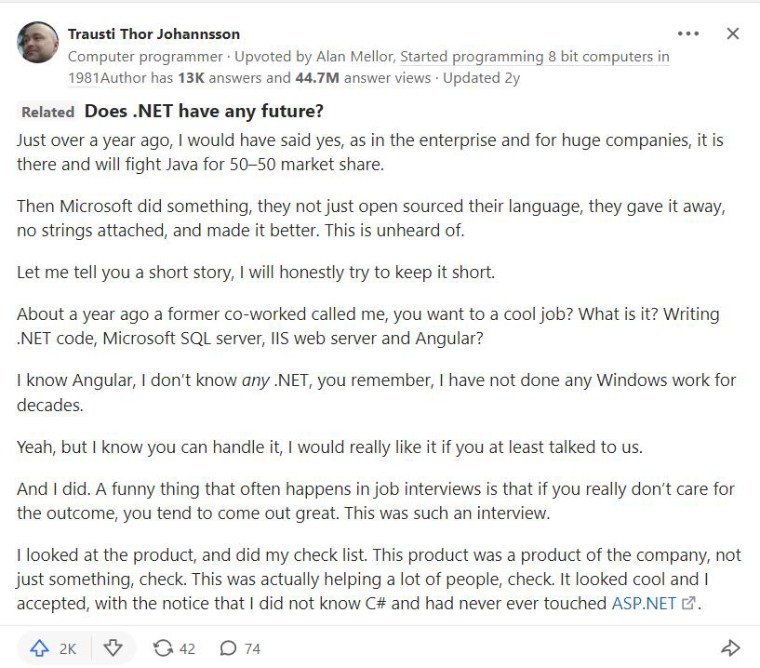
The term .NET technology refers to a broad umbrella that encompasses a wide range of programming languages like C#, F#, and Visual Basic, developer tools such as Visual Studio (an integrated development environment), Visual Studio Code and technology. They also provide best-in-class IDEs for custom .NET app development. Microsoft, as a well-known global service provider, has established a methodical development eco-system for .NET application development, quality assurance, reengineering, and migration.
The speciality of the .NET framework is language-independent. It is compatible with all common computer programming languages and operating systems keeping it within the .NET ecosystem. If we talk about Interoperability in the Dot Net then it is may be classified into three types:
- Interoperability of .Net with COM components
- P/Invoke – it shows how .Net interacts with Win32 DLLs
- .NET interoperability- how COM components work in .NET environment
In the above section, COM stands for Component Object Model and Microsoft established it as a binary-interface standard between two binary modules. One of which is a .NET standard library and the other is a user-run application. It specifies how these two binary modules should meet and interact with one another.
The term “forward compatibility” refers to the ability to access dot net components from COM components using the .Net runtime. Similarly, if the .NET runtime allows access to the old COM Code of the .NET components then it is termed Backward compatibility.
2.5 Storage of Previous Application Versions
Though third-party software should be compatible with current .dll and .exe files produced in .NET, there are times when this is not the case. For example, the software will work on that computer system if the supportive file extension of an application is not matching..NET platform comes in handy in these situations since it stores all prior versions of the .NET code on its software development platform. Or, at the very least, multiple versions that the .NET developer wishes to save. As a result, a .NET developer can collaborate with a company’s IT staff to install an earlier version of the program so that the software can be installed. They can also make changes to an .exe or .dll file to avoid future problems.
Below image shows the previous versions of .NET framework with its release date.
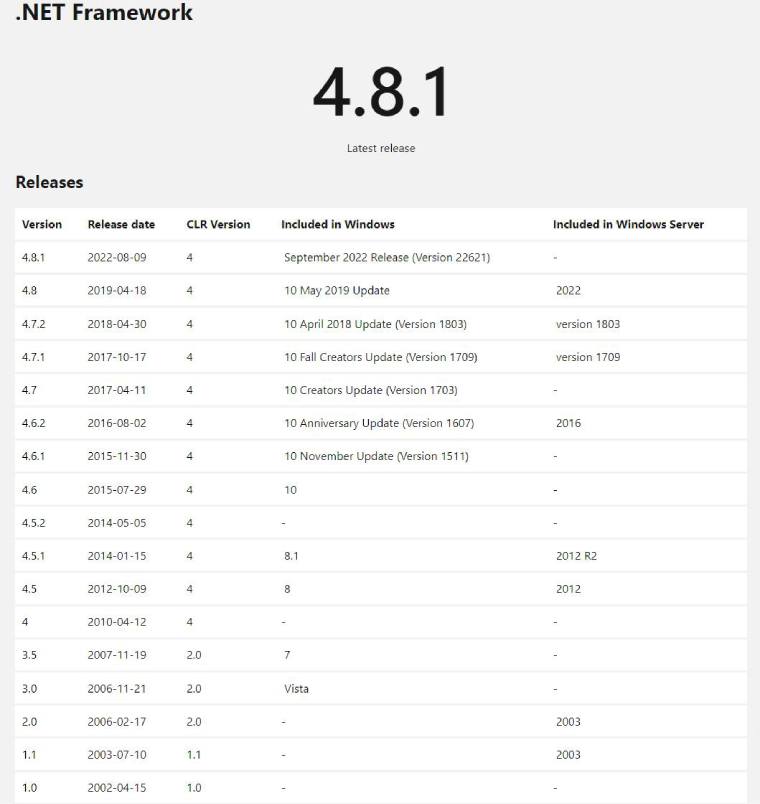
3. Top Three Main Application Models of .NET Framework

The .NET Framework was released in 2002, and it is the first and oldest net implementation. Dot Net framework includes three main application models – WPF, Windows Forms, ASP.NET Forms, and Base Class Library.
1. Windows Presentation Foundation (WPF): It is a UI framework utilized for designing graphical interfaces essentially for desktop customer applications on Windows OS. WPF practices the aptitudes of Extensible Application Markup Language (XAML).
2. Windows Forms: To know more about Windows form, it is a GUI library with classes within the .NET framework. These windows forms allow businesses to develop rich-featured applications that are scalable, and easy to deploy.
3. ASP.NET: While the last one was created for desktop engineering, ASP.NET is applied to develop forms based applications, dynamic websites and web applications. It is the Common Language Runtime (CLR) in its center that allows developers to compose ASP.NET code practicing different .NET languages.
4. Base Class Library (BCL): BCL gives the most basic functions such as classes in namespaces and is the center of the Framework Class Library (FCL), a kit of reusable interfaces, properties, and value standards that are firmly integrated with the Common Language Runtime (CLR). The set of FCL and CLR creates the .NET Framework. The base class library further involves ADO.NET, database interaction technology utilized by developers to obtain databases.
As Dot Net Framework maintains only Windows-based tools, there was a requirement for a cross-platform combination.
4. .NET Components
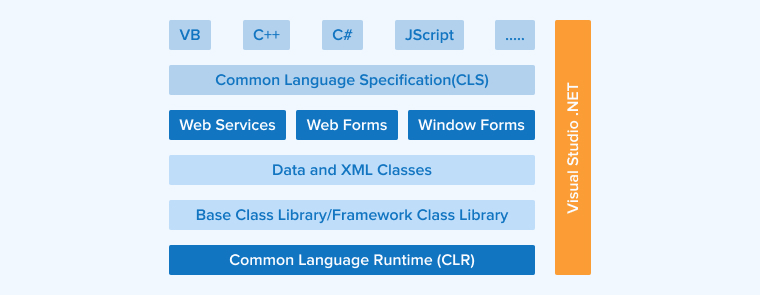
The structure of the .Net framework is created using these key components:
1. Common Language Runtime
The Common Language Infrastructure is a platform in the .Net framework on which the .Net programs are performed.
The key features of CLI:
(i) Exception Handling – Exceptions are faults that happen when the application is done.
(ii) Garbage Collection – Garbage collection is the method of eliminating rejected resources when they are not needed. (iii) Language – The initial level is the programming language, the most famous .NET technologies are VB.Net and C#.
(iv) Compiler – There is a compiler that is different for each programming language. For the VB.Net language, you can find the VB.Net compiler. Likewise, for C#, you can use another compiler.
2. Class Library
The .NET Framework comprises a collection of standard class libraries. A class library is a set of processes and uses that can be practised for the main purpose.
For instance, there is a class library with techniques to manage all file-level operations. So there is a process that can be applied to understand the text from a file. Furthermore, there is a way to record text to a file.
3. Languages
The models of .NET applications that can be developed in the .Net framework are categorized broadly into these categories.
- WinForms – This is practiced for creating Forms-based applications that can run on an end-user device. Notepad is a case of a client-based app.
- ASP.Net – This is practiced for building software applications, which are built to work on any browser like Chrome, or Firefox.
- ADO.Net – This technology is utilized to develop applications to associate with Databases like Oracle or Microsoft SQL Server.
Microsoft always guarantees that .Net frameworks are in agreement with every supported Windows operating system.
5. .Net Framework Design Principle
Now, it’s time to understand the design principles of the .NET framework. You must know what you are creating and what you are utilizing as aspects.
Overall Compatibility
.Net Framework is a backward compatible framework where .Net framework 4.5 and later versions are compatible with the applications built with older versions. This is because Microsoft guarantees that older framework versions work nicely with the latest version with each release.
Portability
Another important aspect of this is portability. Applications created with the.Net framework can run on any Windows platform. Microsoft is also considering making portable platforms that run on other platforms such as iOS and Linux, in recent years. It is also feasible to combine and contrast code written in the various framework-supported languages.
Memory management
Definitely, the Common Language runtime manages all memory. The.Net framework includes the ability to see resources that aren’t currently being used by a running programme. It would then release those resources in accordance with the situation. This is accomplished with the help of a programme named “Garbage Collector,” which is part of the.Net framework. The trash collector runs at regular intervals, looking for unused system resources and freeing them as needed.
Easier deployment
The .Net framework has tools for packaging applications created with it. After that, these packages can be disseminated to client computers. The program would then be installed by the packages.
Safety & Security of app information
The .NET framework offers an inbuilt security facility that validates as well as verifies the entry of any bugs or flaws and prevents it from any type of app performance. Every need of the application is comprehensively explained and managed for security reasons. These security reasons help users easily access source code to an ongoing program
6. Conclusion
In this insightful blog, we have curated all the points that make the .NET programming language a key differentiating technology for businesses. There are many .NET developers who get confused and are not sure of what to choose between the available technologies like .NET or Java. So, here’s an eye-opener for businesses to understand why to choose the .NET stack and how it is secure and compatible compared to other software development technologies. The storage, interoperability and specific architectural build-up are some of the strong reasons why businesses choose .NET.


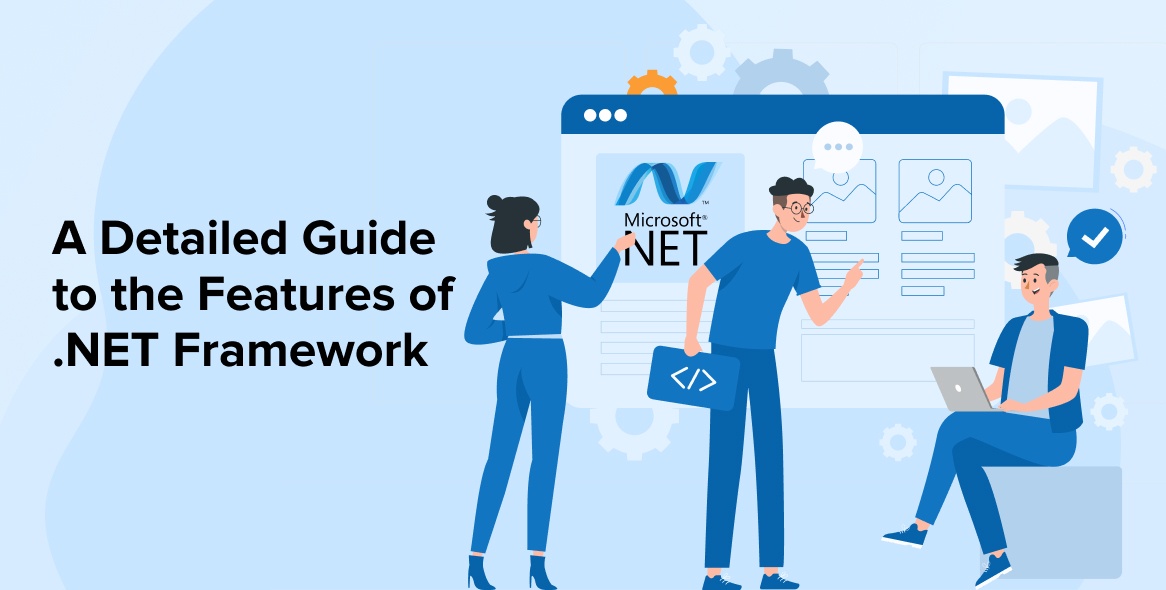



Undoubtedly .NET is the best framework so far which was introduced in 2002 and backed up by the industry giant i.e Microsoft. Also, .NET supports 60 programming languages. It supports various industry standards and provides a wide list of features and functionalities which has made .NET a most chosen framework by businesses for their software solutions. Thanks, writer this was an up to point blog. Enjoyed reading it!!
.NET is the best ecosystem for developing a variety of web and desktop applications. Being a .NET developer I must say that this blog has mentioned all the significant points of .NET for a wannabe .NET developer or the businesses who are looking forward to getting custom software developed using .NET. However, including information on when to go for the .NET framework will help developers to know when to suggest the .NET framework to their clients after studying their software requirements.
A framework designed and developed by the industry giant- Microsoft is worth a read. I am a student of a computer science field and deciding which framework or technology to learn for my career in the software development industry. Thank you so much for this well-drafted article. It has helped me a lot!
.NET is the most loved software development framework not only by developers but also by business owners as they trust it more for security reasons. The .NET framework has a variety of features to develop a variety of web apps and software solutions. I really liked the way the information is presented in the blog. I would definitely share this blog with my teammates.